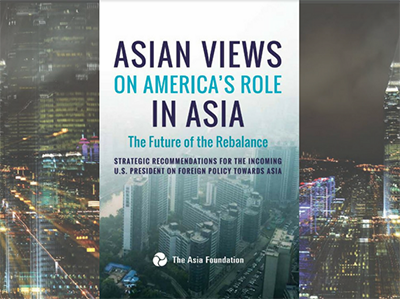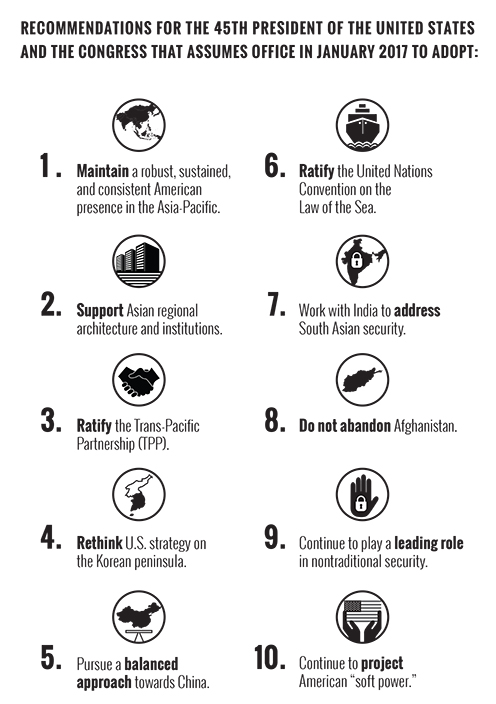Rebalancing trade with Asia while confronting the dark side of globalization
Facing this complex combination of challenge and opportunity, most Asians seek continued U.S. involvement in the region—diplomatically, economically, socially, and militarily.

The world’s largest regional economic cooperation group convened earlier this month in an effort to assure freer Asia-Pacific trade that secures the advantages of globalization while safeguarding the welfare of people hurt by it in the past.
According to the Asia Pacific Economic Cooperation (APEC), all 21 member nations have agreed to place a great emphasis on providing regional economic integration and promoting sustainability in the Pacific Rim — which comprises 3 billion people, half of global trade and 60 per cent of world GDP.
APEC aims to securely reduce administrative bottlenecks at borders and make it easier and less costly to move goods across borders. The group is also addressing non-tariff measures, including in the agriculture and food industry, and strengthening technical capacity for new, more equitable trade agreements. Admittedly, achieving these stated goals won’t be easy.
“We are at the start at what promises to be a difficult year,” acknowledged Vietnam Permanent Deputy Foreign Minister Bui Thanh Son, 2017 Chair of APEC Senior Officials. “Despite some positive predictions, global and regional economic growth remains slow. Global trade is weak, and investment is subdued. There are many uncertainties.”
Amen to that, says the San Francisco-based Asia Foundation, which recognizes that The U.S. “rebalance” towards the Asia-Pacific signals a dramatic shift of economic, political, and strategic power towards the region.
In its annual policy paper, Asian Views on America’s Role in Asia, analysts note that the United States has traditionally served as a coordinator of regional efforts – as a source of investment, especially in civil society, and as a role model of democratic governance.
Foundation researchers also maintain that Asian states are confronting social and political issues such as rapid urbanization, increasing pollution, rising income inequality, and threats to public health.
As a consequence they advise U.S. trade policy makers to continue to provide guidance when it is sought, and partner with civil society organizations to promote the values of democracy and free markets, while avoiding needless hectoring and intervention in the internal affairs of Asian nations.

It should increase cultural and educational exchanges, and encourage participation by U.S. nongovernmental organizations and private institutions in the exercise of American “soft power.”
Facing this complex combination of challenge and opportunity, most Asians seek continued U.S. involvement in the region—diplomatically, economically, socially, and militarily, says Harry Harding, Senior Advisor to the Institute for Public Policy at the Hong Kong University of Science and Technology. 
“On balance, they believe that, despite some important lapses and exceptions, the American role in Asia since the end of the Cold War has benefitted their region by promoting their common interests in security, prosperity, and better governance,” he says.
However, one of the trends that is of greatest concern to Asians today is the extent to which this historic American role in the region has been questioned during the 2016 U.S. presidential election campaign and undermined by budgetary constraints.
Harding adds that some of the main principles in U.S. foreign policy over the last 30 years—a belief in free trade, a firm commitment to the security of its allies, an interest in establishing and strengthening international norms and institutions, and a desire to promote effective and responsive governance and universal human rights—have been questioned by President Trump…as well as by important segments of public opinion.
And even if those debates are resolved in favor of continued U.S. involvement, as APEC and most Asian trade groups hope, they would still like to see some aspects of American policy modified in ways that they believe would better contribute to the security and prosperity of the region.
“The United States can strengthen liberal and modernizing forces in Asia by exercising its unique influence in partnership with local initiatives rather than imposing an agenda on the region and interfering in the internal affairs of states,” says Ellen Laipson, President Emeritus of the nonpartisan foreign policy think tank, Stimson, and co-author of the Asia Foundation report. “Political modernization owned by Asians themselves will enhance America’s political standing and advance her foreign-policy objectives over the long term.”

Article Topics
Blogs News & Resources
Latest in Materials Handling
Registration open for Pack Expo International 2024 Walmart chooses Swisslog AS/RS and software for third milk processing facility NetLogistik partners with Vuzix subsidiary Moviynt to offer mobility solutions for warehouses Materials Handling Robotics: The new world of heterogeneous robotic integration BSLBATT is looking for new distributors and resellers worldwide Lucas Watson appointed CSO for Körber’s Parcel Logistics business in North America Hyster recognizes Dealers of Distinction for 2023 More Materials HandlingAbout the Author
Subscribe to Materials Handling Magazine

Find out what the world's most innovative companies are doing to improve productivity in their plants and distribution centers.
Start your FREE subscription today.
April 2024 Modern Materials Handling

Latest Resources










